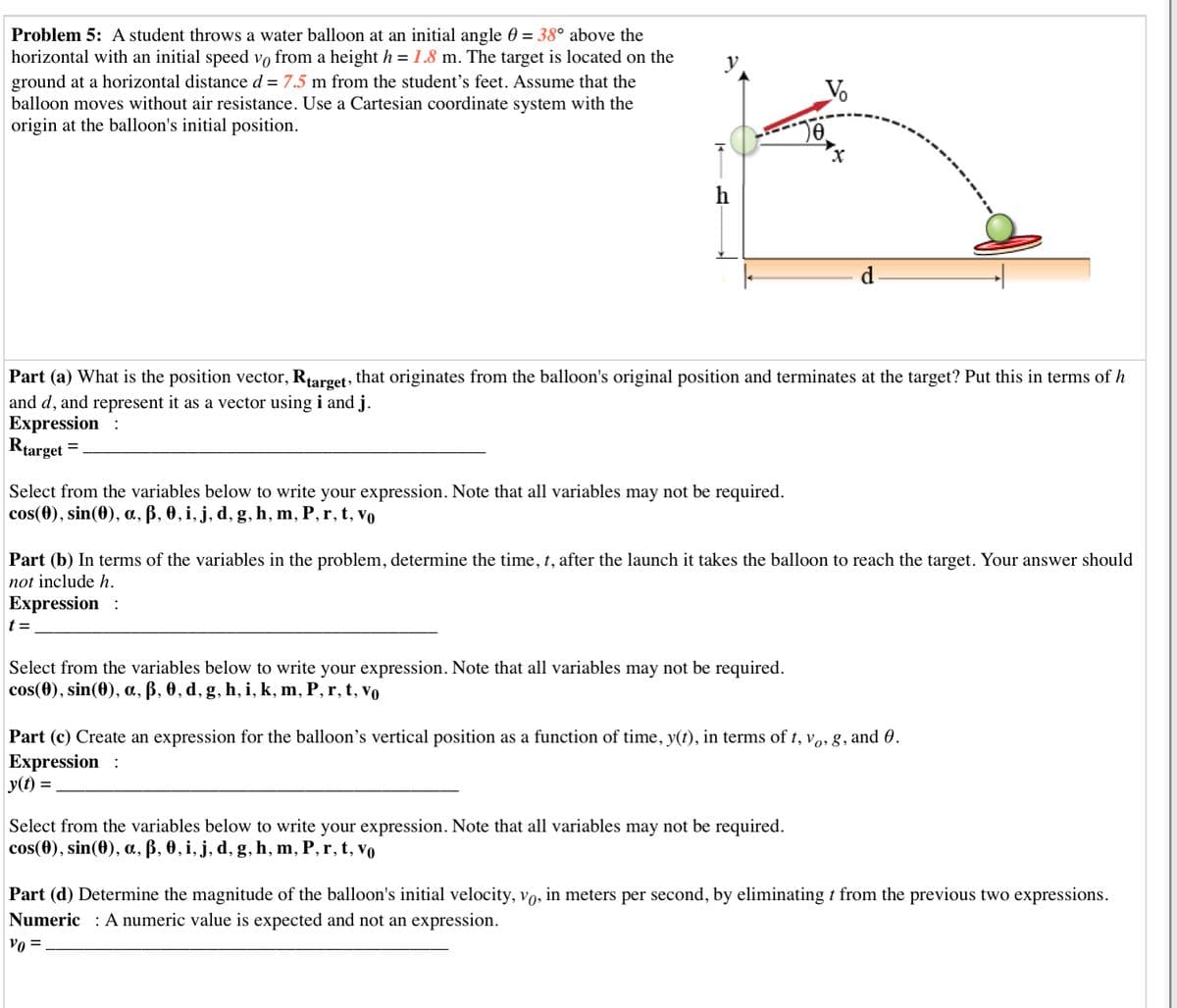Problem 5: A student throws a water balloon at an initial angle 0 = 38° above the horizontal with an initial speed vo from a height h = 1.8 m. The target is located on the ground at a horizontal distance d = 7.5 m from the student's feet. Assume that the balloon moves without air resistance. Use a Cartesian coordinate system with the origin at the balloon's initial position. h d Part (a) What is the position vector, Rarget, that originates from the balloon's original position and terminates at the target? Put this in terms of h and d, and represent it as a vector using i and j. Expression : Rtarget = Select from the variables below to write your expression. Note that all variables may not be required. cos(0), sin(0), a, ß, 0, i, j, d, g, h, m, P, r, t, vo Part (b) In terms of the variables in the problem, determine the time, t, after the launch it takes the balloon to reach the target. Your answer shoule not include h. Expression: %3D Select from the variables below to write your expression. Note that all variables may not be required. cos(0), sin(0), a, ß, 0, d, g, h, i, k, m, P, r, t, vo Part (c) Create an expression for the balloon's vertical position as a function of time, y(t), in terms of t, vo, g, and 0. Expression : y(t) =
Problem 5: A student throws a water balloon at an initial angle 0 = 38° above the horizontal with an initial speed vo from a height h = 1.8 m. The target is located on the ground at a horizontal distance d = 7.5 m from the student's feet. Assume that the balloon moves without air resistance. Use a Cartesian coordinate system with the origin at the balloon's initial position. h d Part (a) What is the position vector, Rarget, that originates from the balloon's original position and terminates at the target? Put this in terms of h and d, and represent it as a vector using i and j. Expression : Rtarget = Select from the variables below to write your expression. Note that all variables may not be required. cos(0), sin(0), a, ß, 0, i, j, d, g, h, m, P, r, t, vo Part (b) In terms of the variables in the problem, determine the time, t, after the launch it takes the balloon to reach the target. Your answer shoule not include h. Expression: %3D Select from the variables below to write your expression. Note that all variables may not be required. cos(0), sin(0), a, ß, 0, d, g, h, i, k, m, P, r, t, vo Part (c) Create an expression for the balloon's vertical position as a function of time, y(t), in terms of t, vo, g, and 0. Expression : y(t) =
Principles of Physics: A Calculus-Based Text
5th Edition
ISBN:9781133104261
Author:Raymond A. Serway, John W. Jewett
Publisher:Raymond A. Serway, John W. Jewett
Chapter3: Motion In Two Dimensions
Section: Chapter Questions
Problem 6P: At t = 0, a particle moving in the xy plane with constant acceleration has a velocity of...
Related questions
Concept explainers
Topic Video
Question
2D

Transcribed Image Text:Problem 5: A student throws a water balloon at an initial angle 0 = 38° above the
horizontal with an initial speed vo from a height h = 1.8 m. The target is located on the
ground at a horizontal distance d = 7.5 m from the student's feet. Assume that the
balloon moves without air resistance. Use a Cartesian coordinate system with the
origin at the balloon's initial position.
Vo
d
Part (a) What is the position vector, Rarget, that originates from the balloon's original position and terminates at the target? Put this in terms of h
and d, and represent it as a vector using i and j.
Expression :
Rtarget
Select from the variables below to write your expression. Note that all variables may not be required.
cos(0), sin(0), o., B, 0, i, j, d, g, h, m, P, r, t, vo
Part (b) In terms of the variables in the problem, determine the time, t, after the launch it takes the balloon to reach the target. Your answer should
not include h.
Expression :
t =
Select from the variables below to write your expression. Note that all variables may not be required.
cos(0), sin(0), a, ß, 0, d, g, h, i, k, m, P, r, t, vo
Part (c) Create an expression for the balloon's vertical position as a function of time, y(t), in terms of t, v,, g, and 0.
Expression :
y(t) =
Select from the variables below to write your expression. Note that all variables may not be required.
cos(0), sin(0), a, ß, 0, i, j, d, g, h, m, P, r, t, Vo
Part (d) Determine the magnitude of the balloon's initial velocity, vo, in meters per second, by eliminating t from the previous two expressions.
Numeric : A numeric value is expected and not an expression.
Vo =
Expert Solution
Step 1
Since you have posted a question with a multiple sub parts, we will solve first three sub - parts for you. To get the remaining sub parts solved please repost the complete question and mention the sub parts to be solved.
Trending now
This is a popular solution!
Step by step
Solved in 2 steps

Knowledge Booster
Learn more about
Need a deep-dive on the concept behind this application? Look no further. Learn more about this topic, physics and related others by exploring similar questions and additional content below.Recommended textbooks for you

Principles of Physics: A Calculus-Based Text
Physics
ISBN:
9781133104261
Author:
Raymond A. Serway, John W. Jewett
Publisher:
Cengage Learning

Principles of Physics: A Calculus-Based Text
Physics
ISBN:
9781133104261
Author:
Raymond A. Serway, John W. Jewett
Publisher:
Cengage Learning